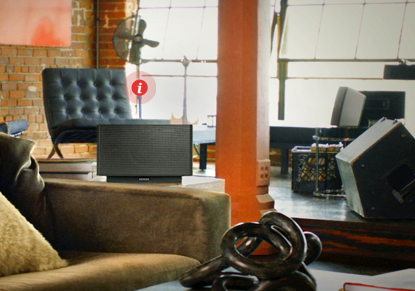Sonos, a great example of a post-PC device (that's not a tablet)


We think of "post-PC" as meaning tablets and smartphones, but there are other things out there that are very "post-PC" without being either of those things.
Sonos -- a wireless music player -- is such a thing. Let's me take you through what it is, why it works, and why it's a perfectly post-PC.
What is it?
Each Sonos "wireless speaker" is an AC powered, self-contained unit that has a number of discrete amps and speaker drivers within. There are three main products: Sonos:3, Sonos:5, and Playbar.
You take a the rooms in your house and put zero or more Sonos speakers in each. Plug them in and they then configure themselves over their own wireless mesh network, ultimately using a bridge to reach over into your broadband and home Wi-Fi.
You can stream music off of computers in your house, or -- providing it can get to your broadband connection -- it can stream from essentially every music service you can think of.
(There are some other products, but these are the basics.)
So that's loads of tech, but the beauty of it is is that you set it up, and all of that tech just disappears. All you get it music.
Attributes
Well, it's good because "you set it up, and all of that tech just disappears". That's the point.
The Sonos stuff has been nicely designed, although they don't have that "lovingly anointed with unicorn tears by fairies" feel of Apple products. But it has that same carefully designed, "gotta keep the end user happy" motive coming through load and clear, and in stereo. (No pun intended.)
My ZDNet colleague Larry Dignan even wrote about how he felt Apple should buy Sonos back in 2009. And they totally should have done.
Defining what a post-PC device is isn't easy. In my upcoming book, Death of the PC, the first chapter looks at doing just that. I now have a working set of seven attributes that I use to determine just how post-PC or pre-post-PC something is.
The seven attributes are: always-available, always-connected, relationship-centric, appliance-like, intimidation-free, monochronistic (one task at a time), and touch-based.
(The attributes in the book are designed to demarcate the difference between PCs, tablets, and smartphones. In hindsight, what it doesn't do so well is help with devices. Perhaps I shall have to go back and revise that chapter given how enlightening Sonos has been.)
Anyway, here are the post-PC attributes that Sonos gets good scores on:
Relationship-centric -- the central purpose has to connect us to the people and things that we love. And we all love music. Well, even if you don't, if you've bought a Sonos -- which is not cheap -- you probably do. So the Sonos is designed around the user's relationship with music.
Appliance-like -- this stuff could not be easier to set-up and use. You plug it all in, run an app on your phone, tablet, Mac, or PC, tell the system where all the various bits are, and off you go. Either stream music from anything on your network, or reach out to music services on the internet. It's a music playing appliance. In the book I talk about this being related to "cognitive loading" -- i.e. just how much conscious effort does it take to make the thing work. Using Sonos creates almost no cognitive loading.
Intimidation-free -- in the book, this is about security, but here is applies to complexity. There's nothing that can go wrong with this system. It updates itself, it's secure, it's locked down and controlled. That means if a relative buys one, you won't get plagued with support calls.
Monochronistic -- it does just one thing, and does it really well. (Monochronistic when we think about post-PC operating systems mean you run one app at a time and jump between them, as opposed to Windows, the WIMP interface of which is polychronistic.)
Goodness
There are plenty of reviews of Sonos, and the idea here isn't to review it. (Although if I did, it's "five stars" all the way.) What examining the Sonos proposition shows you is just how to build something that is either a "good post-PC device", or a "good device for a post-PC" consumer, or both.
Sonos works because it is does one thing fanatically well. The setup portion actually isn't that important -- after all, how often do you set the thing up -- it's the day to day experience that is key.
If you were trying to do this with a PC, it would be a mess. The PC is a flexible multifunctional; device, and not central to your relationship with music. You would have to keep managing the PC to keep it on track in terms of that relationship. ("I've installed an update, now my music won't play.") It's complicated and breaks -- i.e. there's lots of cognitive load and it's not "intimidation free".
Microsoft -- using the design principles they do today of putting the complex, polychronistic, flexible operating system at the centre of everything -- could not have built Sonos, because by important Windows into that mix, you lose the simplicity of a focused design.
Sonos also fits nicely into ubiquitous computing ("ubicomp"). I've written before about how ubicomp informs the post-PC era. A central premise is that technology fades into the background and comes to life when it needs to be used. For most people, music is "aural wallpaper" -- it's not the primary activity that you're doing. It's just something that "decorates" the experience.
The basic proposition of Sonos is faultless. These little, nicely designed boxes fit into the house and just work. There's no fiddling, no mucking about, they are just there when you want them, in the background ready to come to life.
What the engineers have done is focused on one experience for the customer and delivered on that superbly well. They have also abstracted the technology away. Consumers don't care about technology, they don't want it geeky. They just want to put some music on and get on with the ironing.
That's why Sonos wins this game.
What do you think? Post a comment, or talk to me on Twitter: @mbrit.